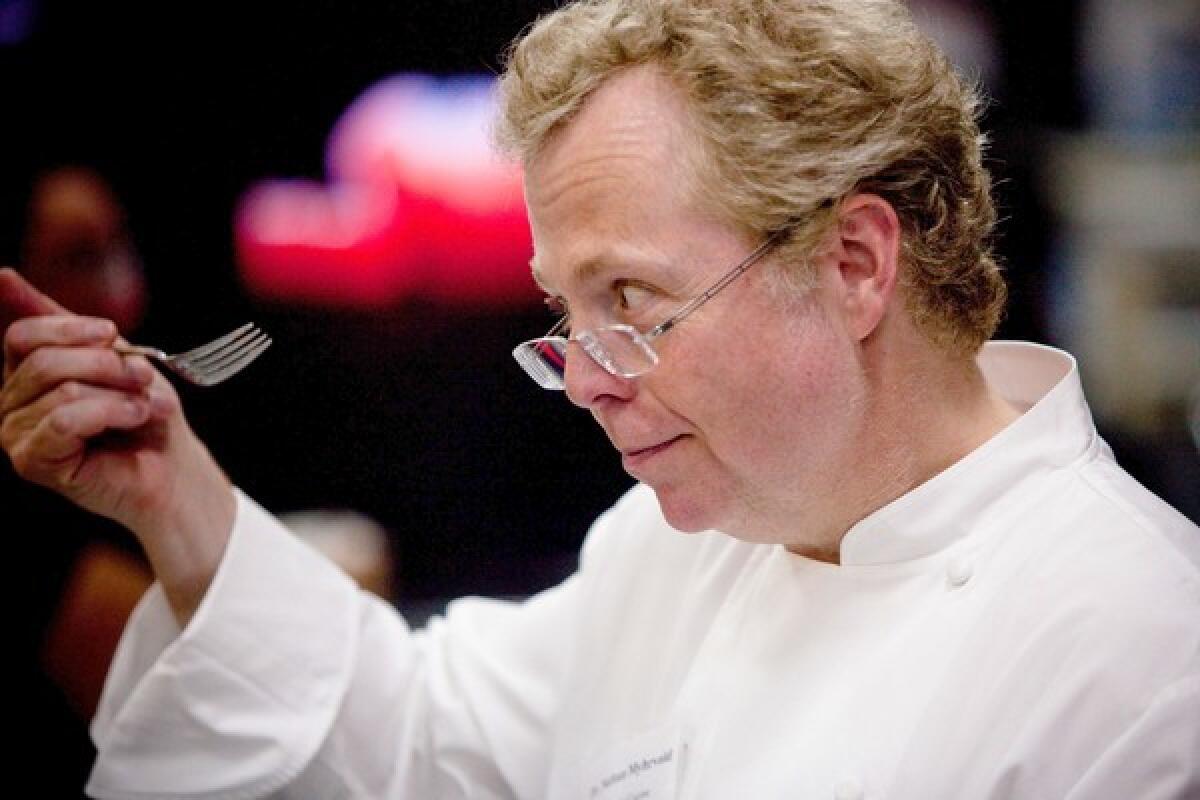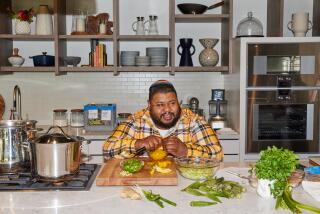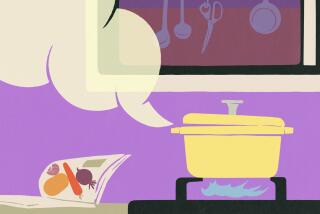The extremist: Nathan Myhrvold and ‘Modernist Cuisine’

Holding the business end of a centrifuge in one hand and a jar of pea solids and their liquid in the other, Nathan Myhrvold explains with a gleam in his eye how to separate pea purée at a force 40,000 times Earth’s gravity. “It’s a fun thing to do to food once in a while,” he says, grinning.
Also scattered around his cooking lab in an office-park warehouse in a Seattle suburb are, among other things, a rotary evaporator (for vacuum distillation, of course), various homogenizers (high-tech blenders), a spray dryer (for turning liquid into powder) and a $250,000 freeze dryer that he bought at a discount from a company gone bankrupt (though he’s a multimillionaire several times over, he’s reportedly quite thrifty).
But there’s more to this than mad scientist and his toys. Former chief technology officer of Microsoft (he managed the development of Windows) and a founder of patent firm Intellectual Ventures, Myhrvold will be coming out with his own highly anticipated cookbook, “Modernist Cuisine,” sometime in the not-too-distant future. He describes it as “an encyclopedic treatment of modern cooking,” including instructions for the avant-garde techniques that have sparked what Myhrvold calls a culinary revolution — think of it as “The Joy of Cooking” for the Ferran Adrià set.
It’s six volumes including a waterproof kitchen manual, 2,400 pages and more than 43 pounds (without its acrylic case). He and his publicists like to say that it weighs as much as a small child and that if you break down the retail price — $625 — it comes to less than $15 a pound. Some are calling it the next Escoffier, or outlandish, or both.
And it’s also late. Until this month, the book, four years in the works, had an expected December release date; it has been pushed back to mid-March. ( Amazon.com and Barnes & Noble’s website have listed it for pre-order since May.)
Now a cadre of 16 full-time editors, designers and photo editors are holed up at the lab, a workshop carved into Intellectual Ventures’ warehouse, intently pushing through the last two volumes.
Myhrvold, a polymath and inventor with a background in space physics and fascinations including paleontology and photography, formed his own publishing company in the midst of writing the book — a tome too daunting for other publishers to tackle. What started as 150 pages or so on sous-vide (cooking vacuum-packed food in water at a relatively low, very stable temperature) snowballed into a magnum opus, the culmination of Myhrvold’s obsession with cooking.
A year ago Myhrvold described the book as three volumes and 1,500 pages, but it obviously continued to grow. “If you talk about sous-vide, then you have to talk about food safety, and microbiology, and heat…,” says Myhrvold, whose co-authors are chefs Chris Young and Maxime Bilet. “Now we laugh that we once thought 800 pages was big…. There are a hundred more things I wish we could have had time to cover.”
What it does cover are topics such as (but not limited to) culinary history, the physics of food and water, modern ovens, thickeners, gels, emulsions, foams, plants, starches, fish, poultry and cuts of meat both tender and tough. There is sous-vide, and there is barbecue. More than 600 pages are devoted to recipes, including the “ultimate burger,” Indian curries and elaborate plated dishes inspired by or adapted from chefs such as Adrià, Heston Blumenthal and Wylie Dufresne.
The aim “was to explain how cooking actually works, the science behind it,” says Myhrvold, who is professorial and inclined to crack wonky jokes. Why boiling often cooks faster than steaming, why a hot wok glows, what happens when you brown a piece of steak. And more. If you want to know about food poisoning and the differences between viral, bacterial and parasitic infections, it’s in there.
“We kept saying we can do this in five pages and then 50 pages later…,” says co-writer Young, who has degrees in biochemistry and math and headed the research kitchen at Blumenthal’s Fat Duck restaurant in England. Myhrvold, Young and Bilet worked alongside several other cooks to develop and test recipes.
“When we started, my hair was short,” adds Bilet, an exuberant Frenchman whose résumé also includes a stint at the Fat Duck and whose wavy coif now reaches his shoulders.
Myhrvold, who occasionally and enthusiastically answers cooking questions with “You have to buy the book!,” won’t say how many he is printing or how much it has cost to publish them, only that “it’s an expensive project and I hope that it will be successful and people will like it.”
From what they have seen so far, some already do. “It represents not only an awful lot of what’s been going on for the past several years in cuisine at the higher levels,” says Nach Waxman, owner of the Kitchen Arts & Letters bookstore in New York, who has been presented with a “flip-through” of some pages by Myhrvold, “but I think it’s going to have effects on even how home cooking is done in the coming years.”
Myhrvold, 51, says he started cooking at age 9 (five years before he started college) when he made Thanksgiving dinner — based on recipes from “The Pyromaniac’s Cookbook.” “It was awful,” he says, laughing, “but not so much that I was discouraged.”
In between other pursuits, he took culinary lessons at Ecole de Cuisine la Varenne in Burgundy, worked in the kitchen of a Seattle French restaurant and won several awards at the world championship of barbecue in Memphis in 1991.
His conversations about sous-vide beginning six years ago on the online forum EGullet were the seed for “Modernist Cuisine.” His entry on March 16, 2004, reads: “I am wondering if anybody has sources for recipes for sous-vide cooking….” It is one of the most popular single-topic threads on the website.
Myhrvold hired former Scientific American senior writer Wayt Gibbs as an editor in 2006, but the book got off to a slow start, according to Gibbs, who calls it “the visual [‘On Food and Cooking’ by] Harold McGee, written by a physicist rather than a chemist.” The project gained momentum after a crackdown by some health officials on vacuum-sealed cooking caused a stir among chefs, and then “Chris came on [in 2007], and once the two of them got together the fireworks really flew,” Gibbs says.
There are step-by-step directions for restaurant techniques developed in the last 30 years, such as sous-vide and reverse spherification. Recipes might include hundreds of variations for, say, hot fruit gels. Many of the 3,500 photographs show what is happening during the cooking process in pots, pans, even microwave ovens that have been cut in half (cleaved with equipment such as an electrical discharge cutter at the lab). “To make some of these topics accessible it was important to have great, compelling photographs,” Myhrvold says.
But the ultimate tech guy, birthing his chef-d’oeuvre in print? “After a lot of soul-searching we decided there was no better way to deliver high-resolution images than print. Why ink? Why paper? Even though I love digital images … it’s still better to have paper.” The book is being printed in China to art-book specifications: on heavy stock, using stochastic screening and wide gamut ink for better pictures. Myhrvold says his favorite statistic is: The ink itself weighs 4 pounds. “The printer made a sample book with blank pages and said it would be a half-inch taller with the ink.”
One reason for the book’s delay is that the printer at one point ran out of the paper. Another is that the packaging for shipping recently failed stress tests, and new packaging is being developed.
Although some publishing industry insiders say it’s over the top, the general reaction is awe. “I’ve been publishing books about cooking for close to 20 years now and have never seen anything quite so ambitious as this,” says Pamela Chirls, an executive editor at John Wiley & Sons, which handles the big glossy cookbooks created by the Culinary Institute of America and who had discussed the book with Myhrvold at an earlier stage. “There is really nothing that even approaches what these books are attempting to do. To the core reader, which I think is a chef, it’s an amazing collection.”
Last month at an open house at the cooking lab to promote the book, Myhrvold held court as servers passed around “ultrasonic fries” and foie gras shaped like Bing cherries. He, Young and Bilet were thronged by a couple dozen of the eminently curious, peppered with questions about the book: whether it would be available digitally (not anytime soon) or volume by volume (no), whether it includes gluten-free recipes (well, some) or if other books are planned (yes).
Though some are skeptical about the “culinary revolution” he’s touting, immersion circulators and whipping siphons and hand-held smokers already have trickled into Sur La Table and Williams-Sonoma. Adrià is teaching classes at Harvard. A subset of home cooks is thrilled at the prospect of having reliable directions for the use of gelling agents such as sodium citrate and sorbitol.
Still, even the food-obsessed might pause at the prospect of spending the price of a New York-to-Paris round-trip flight or a 48-bottle wine storage system with dual temperature zones on a cookbook. “It would make a beautiful coffee-table book,” says Diane Eblin, an avid cookbook collector, at the cooking lab’s open house. “But it costs more than my coffee table.”
betty.hallock@latimes.com
More to Read
Eat your way across L.A.
Get our weekly Tasting Notes newsletter for reviews, news and more.
You may occasionally receive promotional content from the Los Angeles Times.







